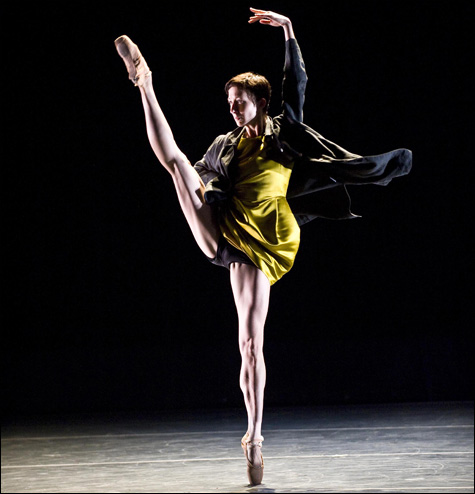
CICADA: Was Nadja Sellrup supposed to be molting? |
A sense of humor is as essential to the soul as dance is to the body. That’s not a truism, and perhaps it’s not even true, but it applies to the program that Stockholm 59° North brought to Jacob’s Pillow two weeks back. The company, which is made up of principals and soloists from the Royal Swedish Ballet, bookended its bill with two serious pieces, Cristina Caprioli’s Cicada (in its world premiere) and Nacho Duato’s Castrati, but it was the darkly comic offerings of Mats Ek in the middle — a pas de deux from Apartment and Pas de Danse — and the personable interpretations that gave the evening its distinction.
In Apartment, a young woman (Marie Lindqvist Friday night) in a simple, almost folky blouse and full skirt appears and knocks at the lighted stage-left door that’s the set’s only feature. A man in a sleeveless shirt (Andrey Leonovich) comes out and they engage in a goofy duet with hints of violence, like Punch and Judy, or Raggedy Ann and Andy playing hopscotch and other children’s games. He disappears behind the door, she follows, the music (Swedish band Fläskkvartetten’s “Innocence”) screams, and, behind the door, we see him ride her off stage.
Pas de Danse finds a man in a white jacket and pants (company director Jens Rosén) alone in the vast interior of a barn or hangar. He hunches his shoulders, looks apprehensive, slaps his face, takes out a large white handkerchief and blows his nose. A woman in a blue dress with a flowing skirt (Jeannette Diaz-Barboza) comes on and tries, with limited success, to get his attention. More nose blowing. An identically attired couple (Oscar Salomonsson and Kristina Oom), except with the colors reversed, run on and it’s party time, as everybody dances up a storm to the accordion-laced strains of Abba member Benny Andersson’s birthday waltz for his second wife, Mona. The man and woman in blue run off together. The man in white reverts. The woman in white sighs and strolls off in the opposite direction. The handkerchief comes out again.
Cicada is summed up by its music: Kevin Volans’s two-piano work of the same name, which in variety and textural interest was dwarfed by the singing of actual dog-day cicadas outside. Nadja Sellrup led off, in a black coat and a chartreuse jumper with a barrel skirt and pockets, walking, posing, balancing, stretching. She was joined by Diaz-Barboza, Oom, Hugo Therkelson, and Pascal Jansson, in similar outfits, black and yellow and gray, the ladies in pointe shoes, all in various combinations of movement, some in canon, incorporating ballet steps like penchée arabesque. It looked generic even before Ek’s two pieces were presented, and more so after. Perhaps the dancers in their jumpers were meant to suggest cicadas molting from their skins.
Castrati, to sacred music by Vivaldi, is Nacho Duato in political mode — which is not his best. Eight men in long black surplices and wristlets run on leaping and whirling like Max Ernst’s Ange du foyer, and you ponder whether they’re the title stars/victims. There are hints of Christ in Gethsemane and the Crucifixion, but the focus turns out to be the ninth man, who’s made to don a surplice and dragged around before he discards the surplice. Eventually the eight form a tight circle and he disappears into the middle of it; something bad is happening, but you don’t know whether he’s being castrated or raped. The Stockholm performance had a hard, polemical edge; Duato’s own Madrid-based Compañía Nacional de Danza might have projected greater ambiguity.